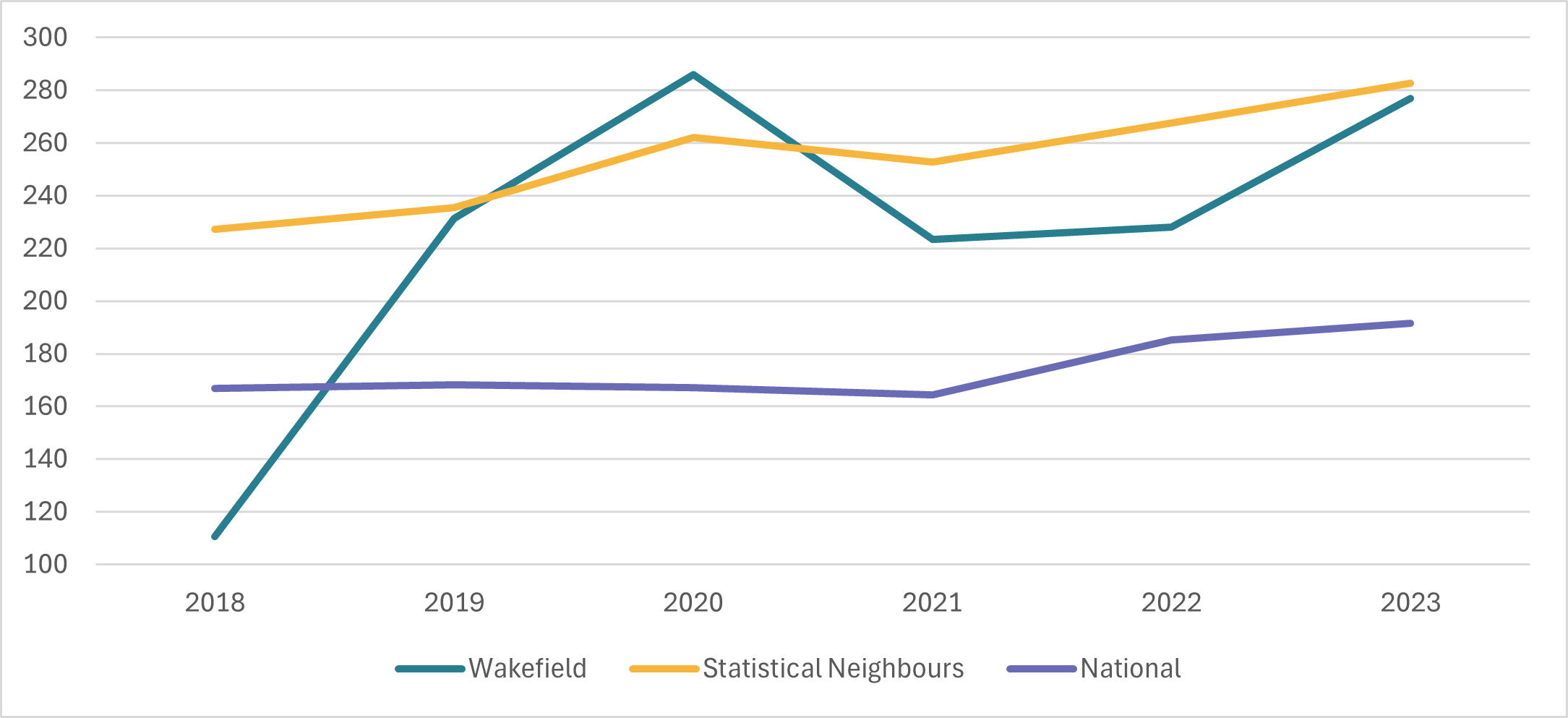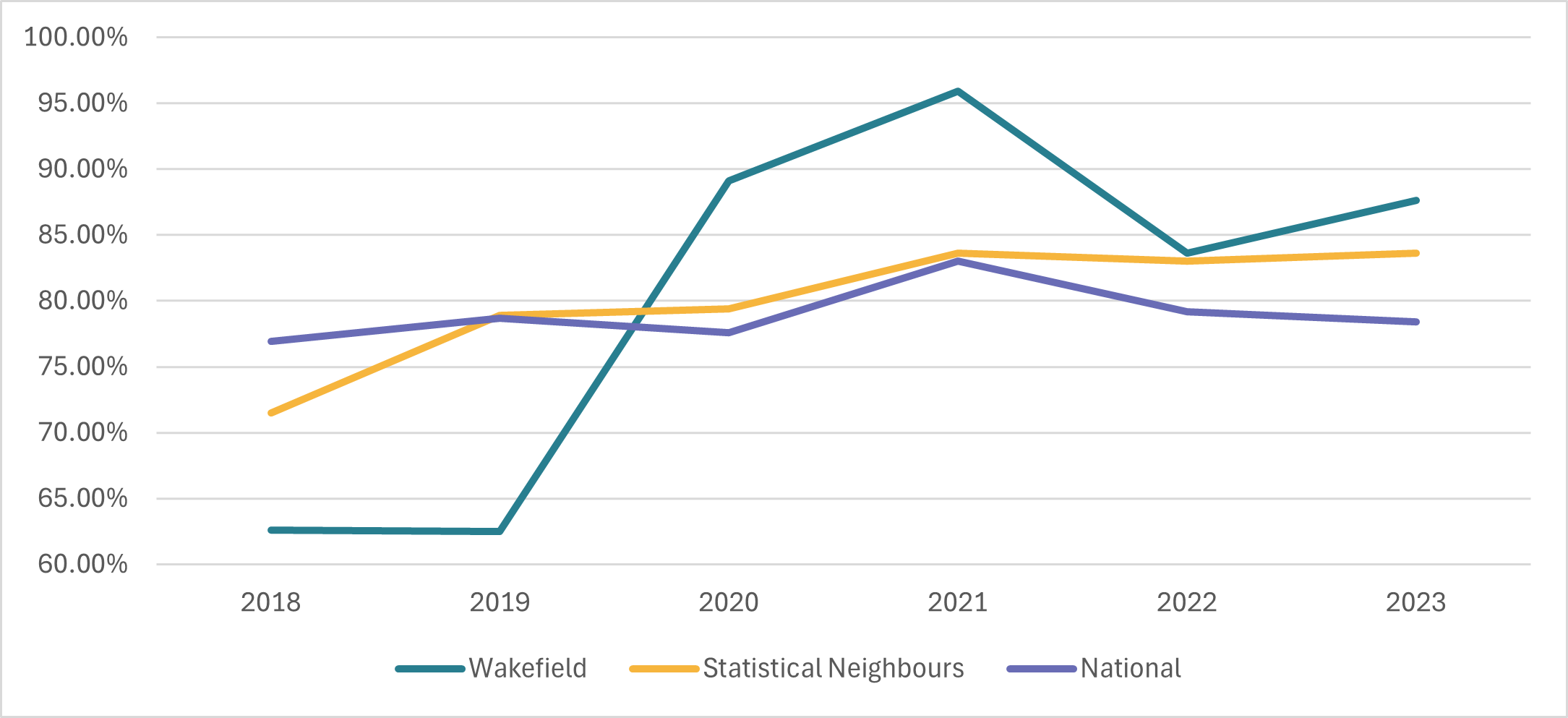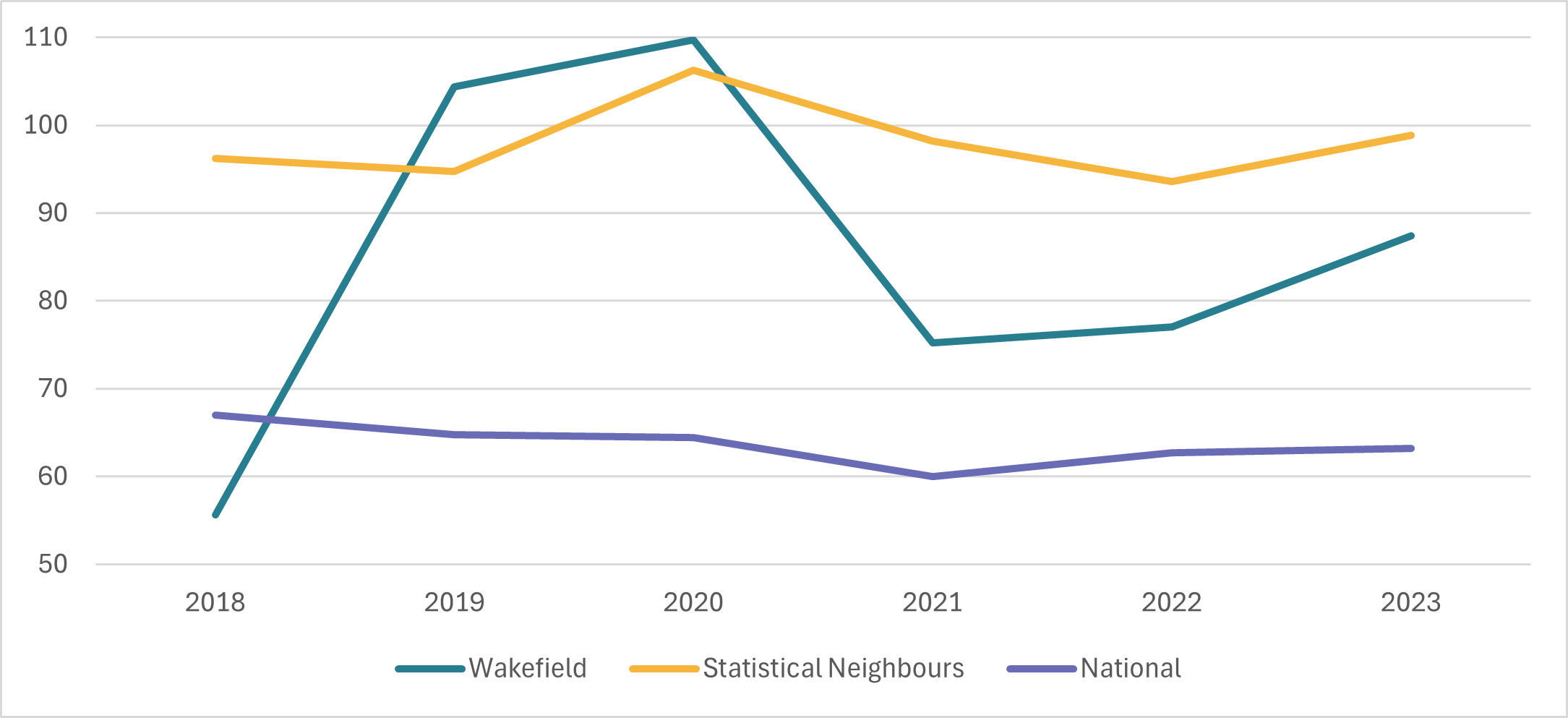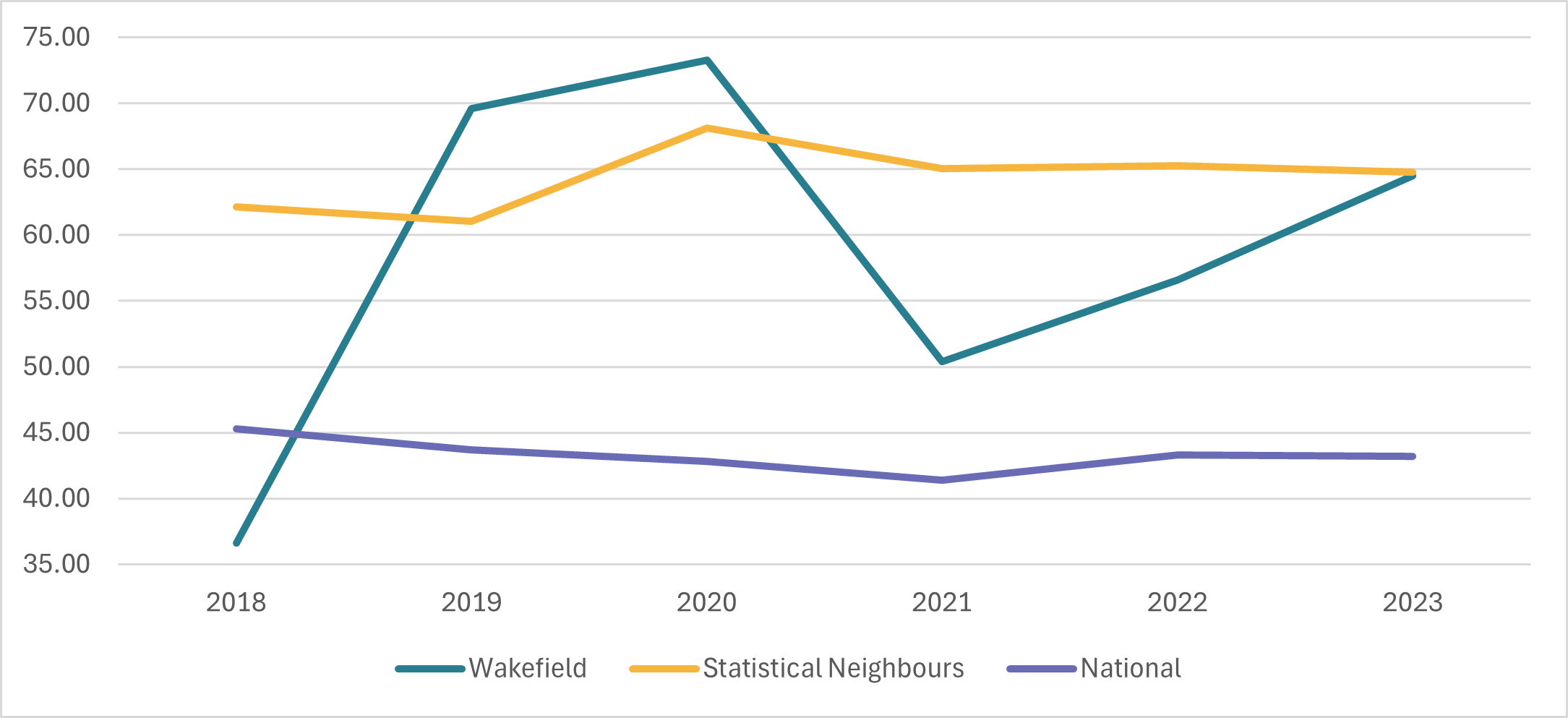1. Headlines
- Following a peak in child protection activity in 2020 there was a general decrease up to 2022, but 2023 saw an increase again in section 47 and Initial Child Protection Conference activity in 2023, however rates remained lower than statistical neighbours.
- There is a higher percentage of children with a Child Protection Plan living in the South East cluster area of the Wakefield District compared to other areas.
- There was a higher percentage of Initial Child Protection Conferences held within timescale in 2023 compared with 2022, evidencing improved processes and compliance.
- The rate of children with a Child Protection Plan (per 10,000 population) reached a peak in 2020 then decreased up to 2022, the increase in 2023 means the rate is in line with statistical neighbours.
- In 2023 a slightly higher percentage of boy were subject to a Child Protection Plan than girls and the most common reason for a Child Protection Plan was neglect.
- The percentage of children who became subject of a plan for a second or subsequent time in Wakefield was in line with statistical neighbours and the national rate.
A common held ambition is that all children should be able to grow up into confident, healthy and happy adults and whilst the majority of children generally enjoy a positive childhood experience within their own family, some children and young people experience a degree of physical, emotional or sexual abuse and neglect which has a significant impact on their lives. Everyone whether they are parents, wider family members, neighbours, friends or members of a community, have a role to play in maintaining the safety and welfare of children and young people, supporting the aims of safeguarding. Those who work with children and young people have more formal responsibilities to safeguard children and young people. Working Together to Safeguard Children (HM Government, March 2023) sets out the statutory framework for this defining the responsibilities of those who work with children along with the responsibilities of agencies and organisations. Working Together states that people working with children are expected to report concerns about a child’s welfare to the relevant agencies.
The maltreatment of children, physically, emotionally, sexually, or through neglect, can have major long-term effects. This can be on all aspects of a child’s health, development and wellbeing. This type of maltreatment is often referred to as adverse childhood experiences (ACEs) and research has shown that the immediate and longer term impact of ACEs can lead to anxiety, depression, substance misuse, eating disorders and self-destructive behaviours, difficulties in maintaining relationships, offending and anti-social behaviour as children move into adulthood. Maltreatment is likely to have a deep impact on a child’s self-image, self-esteem and their future life. The high cost of ACEs, both to individuals and to society, underpins the duty on all agencies to be proactive in safeguarding children.
When Wakefield Council’s Children Social Care Service identifies there is reasonable cause to suspect a child is suffering abuse or neglect or is at risk of suffering significant harm, it will carry out an assessment under section 47 of the Children Act 1989 to determine if it needs to take steps to safeguard and promote the welfare of the child.
Initially a Strategy Discussion will be held attended by Police, Health and other key with partner agencies such as Education and voluntary sector services to determine what information is known about the child and their family. If significant concerns are identified a Section 47 Investigation will commence to gather all the relevant information. A Section 47 Investigation may be carried out when an initial concern is raised with the Service or at any another time where the child already has an open case with Children’s Social Care. If concerns are substantiated and the child is judged to be at continuing risk of harm then an Initial Child Protection Conference (ICPC) will be held within 15 working days of the Strategy Discussion.
At the ICPC, the information gathered is reviewed and the decision will be made as to whether the child needs to become the subject of a Child Protection Plan. This sets out the action that needs to be taken, by when and by whom to keep the child safe from harm and to promote their welfare. Once implemented, the plan will be reviewed at regular Review Conferences until the child is no longer considered at risk of significant harm and there has been effective and sustainable change. At this point the child or young person may become a child in need to ensure changes are being sustained or they may be referred for support to non statutory services such as the Wakefield Targeted Early Help Service. If there is no change in the circumstances for the child or young person or behaviour of the parents or carers or there is an escalation in risk or safety for the child or young person they may be taken into care. For more information on children in care data within Wakefield, please see the children in need page on this website.
The following summary of data relating to Child Protection in Wakefield provides population level information and considers how this compares to rates in England along with the rates for other similar local authority areas knows as statistical neighbours for Wakefield. This data is published annually by the Department of Education based on the financial year to 31st March and is collected through the Child in Need Census which is submitted by all local authorities. Where it has been found that data for Child Protection in Wakefield varies significantly from statistical neighbours or where there is an increasing or decreasing trend over time, then some recommendations are made and commentary is provided on whether this is currently being addressed or if further action is required.
2. The Population
Section 47 Investigations
Table 1 – Rate of Section 47 Investigations Starting in the Year
| 2019 | 2020 | 2021 | 2022 | 2023 | |
| Wakefield | 231.40 | 286 | 223.50 | 228.10 | 276.90 |
| Statistical Neighbours | 235.48 | 262.22 | 252.85 | 267.55 | 282.55 |
| National | 168.30 | 167.20 | 164.40 | 185.20 | 191.60 |
Figure 1 – Rate of Section 47 Investigations Starting in the Year

Latest available published data shows that the rate (per 10,000 population) of Section 47 Investigations (where there were serious concerns about a child) starting in the year has increased since 2021, with the rate for 2022 being 228.1 and the rate for 2023 being 276.9 for Wakefield per 10,00 population.
The 2023 rate of 276.9 is slightly lower than the statistical neighbour rate of 282.55 and shows that similar numbers of investigations were carried out in Wakefield as in other Local Authority areas with similar populations, demographics and levels of deprivation, but higher than the national rate of 191.60. The rates since 2019 have been much higher than the previous year and much closer to the statistical neighbour rates which indicates that Wakefield is identifying risk appropriately and the volume of this activity is consistent with other similar Local Authorities.
Initial Child Protection Conferences
Table 2 – Percentage of Initial Child Protection Conferences Held Within 15 Days
| 2019 | 2020 | 2021 | 2022 | 2023 | |
| Wakefield | 62.50% | 89.10% | 95.90% | 83.60% | 87.60% |
| Statistical Neighbours | 78.90% | 79.40% | 83.60% | 93.00% | 83.60% |
| National | 78.70% | 77.60% | 83.00% | 79.20% | 78.40% |
Figure 2 – Percentage of Initial Child Protection Conferences Held Within 15 Days

To ensure plans are put in place in a timely way when there is significant risk for children and young people, an Initial Child Projection Conference (ICPC) should be held within 15 days from a Strategy Discussion (if deemed appropriate from the Section 47 Investigation). The Conference will be attended by key partner agencies such as Health, Education, Police as well as Children’s Social Care and at the Conference a decision will be made on whether a Child Protection Plan is required.
In 2023 there was an increased rate of ICPCs held within timescale compared with 2022 with 87.6% completed on time. The rate was higher than the statistical neighbour rate of 83.6% respectively, and the national rate of 78.4%. Improving on this rate is a constant focus for the Safeguarding Review Unit who co-ordinate the Conferences and when these are held out of timescale any learning is identified to improve processes.
Table 3 – Rate of Initial Child Protection Conferences
| 2019 | 2020 | 2021 | 2022 | 2023 | |
| Wakefield | 104.40 | 109.70 | 75.20 | 77.00 | 87.40 |
| Statistical Neighbours | 94.76 | 106.22 | 98.18 | 93.58 | 98.81 |
| National | 64.80 | 64.4 | 60.00 | 62.70 | 63.20 |
Figure 3 – Rate of Initial Child Protection Conferences

The rate of ICPCs being held (per 10,000 population) increased in 2023 to 87.40 which is the highest rate since 2020, however this remained below our statistical neighbour rate of 98.81, but above the national rate of 63.20. Since 2021, the Wakefield rate of ICPC’s has been below the Statistical neighbour rate but above the national rate.
Child Protection Plans
Table 4 – Rate of Child Protection Plans Starting in Year
| 2019 | 2020 | 2021 | 2022 | 2023 | |
| Wakefield | 97.10 | 100.50 | 71.30 | 72.90 | 81.80 |
| Statistical Neighbours | 82.04 | 92.46 | 88.88 | 86.97 | 88.47 |
| National | 55.80 | 55.2 | 52.80 | 54.70 | 54.30 |
Since a peak in 2020, there has been an increasing trend in the rate of Child Protection Plans starting in the year and the increase has been sharper from 2022 to 2023 increasing to 81.80 from 72.90. There has been a similar increase for our statistical neighbours, with their 2023 rate of 88.47 being above the Wakefield rate, whilst the national rate has remained fairly level over the same period with a rate of 54.30 in 2023.
For children subject to a Child Protection Plan, the trend has fluctuated somewhat over the last 4 years. The rate of children (per 10,000 population) peaked in 2020, then decreased up to 2020 but the rate has since increased again in 2023 up to 64.5. The 2023 rate was very similar to the statistical neighbour rate of 64.79 but higher than the national rate of 43.20. Both the statistical neighbour and national rate have remained more stable in the same period. The fluctuation in Wakefield may be related to the ongoing impact of Covid-19 as in Wakefield Safeguarding services continued to operate normally during the period whilst other services were more restricted and there were more children with more complex presentations.
There is regular auditing of cases at each stage of the child protection process to ensure decision making is robust and the length of time that children are on a plan is regularly reviewed to determine whether expected change is achievable, risks are reduced and outcomes are improving.
Table 5 – Rate of Children Subject to Child Protection Plan (per 10,000 population)
| 2019 | 2020 | 2021 | 2022 | 2023 | |
| Wakefield | 69.60 | 73.3 | 50.40 | 56.60 | 64.50 |
| Statistical Neighbours | 61.05 | 68.10 | 65.04 | 65.27 | 64.79 |
| National | 43.70 | 42.80 | 41.40 | 43.30 | 43.20 |
Figure 4 – Rate of Children Subject to Child Protection Plan

The data in the charts below provide more detail on children who have been on a Child Protection Plan between 2018 and 2023. This includes all plans and not just those subject to a plan at the end of the financial year. Different years, age groups and geographical areas can be selected through using the filters provided.
In the last 5 years, the most commonly identified category of abuse identified for children subject to a Child Protection Plan was neglect. The Wakefield Children’s Safeguarding Partnership have implemented a neglect toolkit to improve identification of neglect at an earlier stage which is available for all professionals who work with children. Emotional Abuse was the second most common category of abuse of the last 5 years.
3. Challenges
Table 6 below shows that in 2023, 23.5% of children starting on a Child Protection Plan were subject to a repeat plan, which was in line with the statistical neighbour rate of 23.40% and the national rate of 23.60%. Children who are subject to a repeat plan are audited to understand the reasons for the subsequent plan and learning from this informs developments in practice.
Table 6 – Percentage of Children Who Became Subject of Plan for Second or Subsequent Time
| 2019 | 2020 | 2021 | 2022 | 2023 | |
| Wakefield | 24.20% | 19.50% | 20.00% | 27.00% | 23.50% |
| Statistical Neighbours | 20.10% | 21.60% | 22.30% | 23.30% | 23.40% |
| National | 20.80% | 21.90% | 22.10% | 23.30% | 23.60% |
Key Findings Recommendations
The 2023 data is remains fairly consistent with statistical neighbour data although there has been an increase in some activity such as section 47 investigations and ICPCs. Having considered the key messages from the data the following recommendations have been identified:
- Continue to ensure that children who are at potential of risk are identified and the appropriate statutory processes are undertaken which is evidenced by sustaining the rate of Section 47 Investigations and Initial Child Protection Conferences
- Ensure the improvement in the rate of ICPCs completed within 15 days seen in 2023 is sustained
- As there is a higher percentage of children on a Child Protection Plan living in the South East cluster area, further analysis could help identify themes and primary needs to inform any targeted work to reduce the volume
- Consider if improvements in practice and across the Children’s Social Care Service is required to prevent the needs of children and young people escalating so that a Child Protection Plan is required through more effective early intervention.
4. How are Children with Child Protection Plans Supported?
Children’s Social Care
In Wakefield, services for children, young people and their families are described within the Continuum of Need. This has been developed through the Wakefield Safeguarding Children’s Partnership in conjunction with other agencies such as Health, Police and voluntary organisations and is consistent with Working Together to Safeguard Children (2018). It describes the level of support available for children and young people depending on their level of need from services which are available universally and for all such as dentists, GPs and schools through to services for children and young people with significant and complex needs. The aim is that children and young people will receive support at the earliest possible stage when required to prevent issues from becoming more serious. Support may be provided through a range of services such as Health Visitors, Community Based Groups, in Children Centres and through the Early Help Service in the Children First Hubs.
For children and young people who have been assessed as having serious complex needs will receive support at level 4 of the continuum of need, and will receive support from a Social Worker. In some situations a child or young person may have received support at an earlier stage eg level 2 or 3 but this may not have been successful in resolving issues or reducing risks.
Support for children and young people in need is provided through Social Work teams, although it is likely that children and young people may also receive other types of support eg attending a group work programme through the Children First Hubs, accessing emotional health support or having respite care. Some of this support may be delivered by partner agencies such as Health and Schools. For children with a Child Protection Plan, the initial plan will be developed through the ICPC which will detail what interventions are required to improve outcomes for children.
The child or young person will be visited on a very regular basis by their Social Worker (every 10 days) who will work with the child and their family to make positive changes to address issues and reduce risks of harm. Progress on the Child Protection Plan will be reviewed at multi agency meetings called Core Groups and also at Review Child Protection Conferences and if there is evidence of improved outcomes then the child or young person will be de-registered from their plan. They will receive support at a lower level with a Child in Need Plan for a short period to ensure improvements are sustained. If there is no improvement for the child or young person, The Child Protection Conference Chair may decide that the case needs to be escalated and legal proceedings may commence with the child or young person coming into care.
Within the Children’s Social Care Service there is also a specific Children Vulnerable to Exploitation Team which works to reduce risks for children who go missing as well as those at risk of exploitation such as sexual exploitation and criminal exploitation.
Wakefield Safeguarding Partnership
Wakefield Safeguarding Partnership is led by Wakefield Children & Young People Services, Wakefield Clinical Commissioning Group and West Yorkshire Police. Working alongside other partners, the partnership co-ordinate and ensure the effectiveness of work to protect and promote the welfare of children recognising that maintaining and promoting the safety and welfare of children and young people requires a multi agency approach.
Wakefield Families Together
Wakefield Families Together is an approach which was launched in 2020 to establish community based teams drawn from professionals from different agencies. These agencies include: Children First Hubs, Children’s Social Care, Health, Police, The Third sector and community services to ensure children, young people and families are supported at the earliest possible stage. The teams are co-located to work alongside each other across the 6 cluster areas in Wakefield. The work is focused community need. Schools are central as part of the local community helping to drive and support families. Schools have linked workers and regular meetings to offer consultations where it is felt families may require additional support. The aim is work collaboratively and to ensure resources are in place to meet need at the earliest stage. More information is found here:
Wakefield Families Together – Wakefield Families Together
